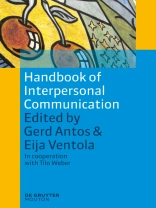Interpersonal communication (IC) is a continuous game between the interacting interactants. It is a give and take — a continuous, dynamic flow that is linguistically realized as discourse as an on-going sequence of interactants’ moves. Interpersonal communication is produced and interpreted by acting linguistically, and this makes it a fascinating research area. The handbook, Interpersonal Communication , examines how interactants manage to exchange facts, ideas, views, opinions, beliefs, emotion, etc. by using the linguistic systems and the resources they offer. In interpersonal communication, the fine-tuning of individuals’ use of the linguistic resources is continuously probed. The language used in interpersonal communication enhances social relations between interactants and keeps the interaction on the normal track. When interaction gets off the track, linguistic miscommunication may also destroy social relationships. This volume is essentially concerned with this fine-tuning in discourse, and how it is achieved among various interactant groups.
The volume departs from the following fundamental questions:
- How do interpersonal relations manifest themselves in language?
- What is the role of language in developing and maintaining relationships in interpersonal communication?
- What types of problems occur in interpersonal communication and what kind of strategies and means are used to solve them?
- How does linguistically realized interpersonal communication interact with other semiotic modes?
Interpersonal communication is seen and researched from the perspective of what is being said or written, and how it is realized in various generic forms. The current research also gives attention to other semiotic modes which interact with the linguistic modes. It is not just the social roles of interactants in groups, the possible media available, the non-verbal behaviors, the varying contextual frames for communication, but primarily the actual linguistic manifestations that we need to focus upon when we want to have a full picture of what is going on in human interpersonal communication.
It is this linguistic perspective that the volume aims to present to all researchers interested in IC. The volume offers an overview of the theories, methods, tools, and resources of linguistically-oriented approaches, e.g. from the fields of linguistics, social psychology, sociology, and semiotics, for the purpose of integration and further development of the interests in IC.,
Topics e.g.:
- Orientation to interaction as primarily linguistically realized processes
- Expertise on theorizing and analyzing cultural and situational contexts where linguistic processes are realized
- Expertise on handling language corpora
- Expertise on theorizing and analyzing interaction types as genres
- Orientation to an integrated view of linguistic and non-linguistic participant activities and of how interactants generate meanings and interact with space
- Expertise on researching the management of the linguistic flow in interaction and its successfulness.
Содержание
I. Theories, methods, and tools of interpersonal communication research
1. Introduction: Interpersonal communication- a linguistic point of view
Eija Ventola & Gerd Antos
2. Social psychology and personal relationships: Accommodation and relational influence across time and context
Margaret J. Pitts & Howard Giles
3. Ethnomethodology and conversation analysis
Johannes Wagner & Dennis Day
4. Interactional sociolinguistics/ anthropological linguistics
Susanne Günthner
5. Interactional linguistics
Dagmar Barth-Weingarten
6. Systemic functional linguistcs
Geoff Thompson
7. Functional pragmatics
Angelika Redder
8. Methods and tools in interpersonal communication research: Data and transcription
Arnulf Deppermann & Wilfried Schütte
II. Linguistic and multisemiotic resources and their interplay in managing interpersonal communication
9. Linguistic resources for managing interaction
Margret Selting
10. Dynamic processing of discourse
Barbara Fox
11. Face-to-face communication and body language
Paul Thibault
12. Technically mediated interpersonal communication
Caja Thimm
13. Feeling space: Interpersonal communications and spatial semiotics
Louise Ravelli & Maree Stenglin
III. Interpersonal communication on-track and off-track
14. Socializing: Social chats in everyday communication
Tilo Weber
15. Counselling, diagnostics and therapy
Peter Muntigl
16. Adolescents, discourse and interpersonal management
Jannis Androutsopoulos & Alexandra Georgakopoulou
17. Discourses with and between seniors (Arbeitstitel)
Anna-Maija Korpijaakko Huuhka & Anu Klippi
IV. Working on conversational strategies
18. Relational work: Politeness and identity construction
Miriam Locher
19. Humour, jokes and irony, mocking, gossip; black humour
Alexander Brock
20. Praising and blaming, applauding, and disparaging — solidarity, audience positioning, and the linguistics of evaluative disposition
Peter R. R. White
21. Silence and taboo
Hartmut Schröder & Sabine Krajewski
Об авторе
Gerd Antos, Martin Luther Universität Halle-Wittenberg, Germany; Eija Ventola, University of Helsinki, Finland.












